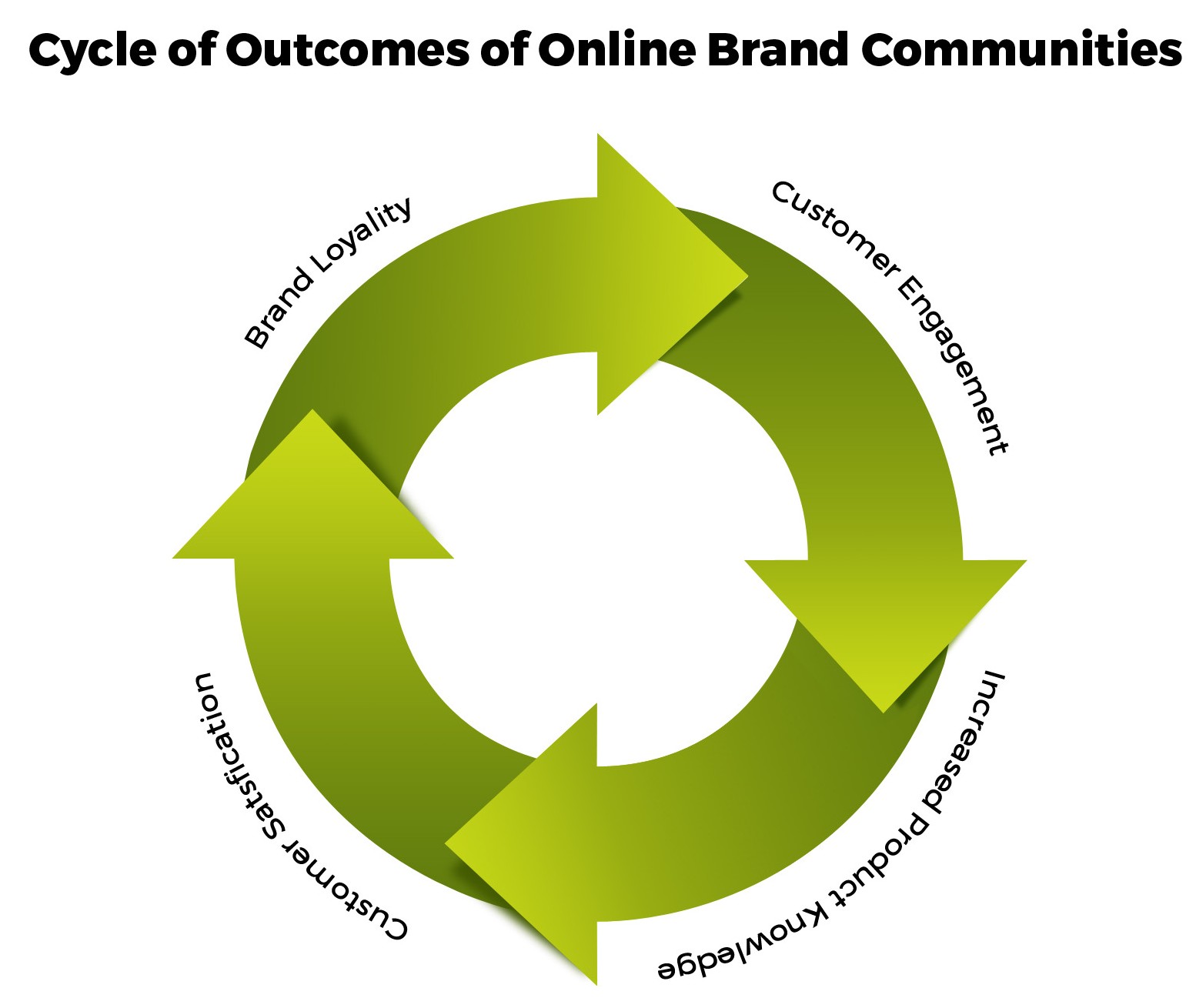guest contribution by Lacie Larschan and Jay Kandampully
 In recent years, firms have realized some of the unique advantages of customers’ active engagement – both with the firm and with other customers – and are increasingly promoting customer participation via brand communities. Opportunities to enhance firm-to-customer and customer-to-customer interaction have risen along with the contemporary climate of the Internet, social media and mobile technology, such that brand communities are being accepted and used by both customers and firms as open and interactive platforms for mutual benefit.
In recent years, firms have realized some of the unique advantages of customers’ active engagement – both with the firm and with other customers – and are increasingly promoting customer participation via brand communities. Opportunities to enhance firm-to-customer and customer-to-customer interaction have risen along with the contemporary climate of the Internet, social media and mobile technology, such that brand communities are being accepted and used by both customers and firms as open and interactive platforms for mutual benefit.
 Lacie Larschan’s, CMO of Rumble Talk, provides a non-academic interpretation of an academic articles on brand communities published in the Journal of Service Management (Wirtz et al. Vol 24 Issue 3, 2013). Lacie’s three part blog series was originally published on rumbletalk.com, a group chat software company founded in Tel Aviv.
Lacie Larschan’s, CMO of Rumble Talk, provides a non-academic interpretation of an academic articles on brand communities published in the Journal of Service Management (Wirtz et al. Vol 24 Issue 3, 2013). Lacie’s three part blog series was originally published on rumbletalk.com, a group chat software company founded in Tel Aviv.
Understand What Drives Customers
Growing up in a small rural town, the common interests of which to base my community were limited, circumstantial, and mostly geographic.
“We ride the same bus to school and have the same teacher? Wow, we have so much in common!”
But today, with the invention and dissemination of the Internet, people from all corners of the world are able to form communities based on whatever truly interests them and are no longer restricted by what geographically limits them.
Organizing niche online communities is a new frontier in business and marketing. The academic world is exploring and conducting research on this topic and the coming results are sure to give a better understanding of the phenomenon that so many of us are already participating in.
The Journal of Service Management published an article titled Managing Brands and Customer Engagement in Online Brand Communities. I found the article to be eye-opening and encourage anyone interested in working with online communities to read the full paper here.
 Getting Started With Online Brand Communities
Getting Started With Online Brand Communities
Brand communities existed before the advent of the Internet. These are communities formed by brand-customer engagement. You’ve probably participated in some level of a traditional brand community, be it as simple as a loyalty program at a movie theater or a sports car club.
Naturally, an online brand community occurs when that brand-customer engagement happens online. Social media made this abundantly possible and marketing teams have been more and more creative in using these tools to further their online brand communities.
To meet the needs of customers in this customer-brand online engagement, it is helpful to understand what drives a customer to engage in the first place. The review of online brand community research found that there are three main “drivers” that push customers across the threshold from not engaging to being part of the online brand community. These are:
- Brand-related Drivers
- Social Drivers
- Functional Drivers
Let’s take a closer look.
BRAND RELATED DRIVERS
There are two kinds of brand-related drivers; the first being brand identification or when a person has a personal identification with the brand. This is when your customer feels that your brand is part of who they are.
Think of a musician who would say “I play a Fender guitar and it is my passion and livelihood, it is who I am!” The musician is driven to participate in the Fender online brand community because it is a space with other passionate Fender enthusiasts to share and reaffirm their identity.
Then there is the brand’s symbolic function. A customer may be driven to engage with an online brand community if they believe in what the brand stands for. I personally am a fan of the Rubik’s Cube. It’s a symbol for logic and more broadly intellect. In either brand-related driver, the motivation is within the customer because of their devotion to the product.
SOCIAL DRIVERS
When I lived in Washington, D.C., one of my favorite events was the National Book Festival. I was “driven” to attend the festival each year because of the social benefits. There, I could browse recently published books and participate in the author’s Q&A session. Attendees would chat while waiting in signing lines which was a great place to get recommendations for similar books.
This, of course, was a traditional brand community (the brand being the National Book Festival) but the social drivers are the same for online brand communities as well. Customers are motivated to engage with online brand communities to receive social benefits. In the example above these would be the exposure to new books, the Q&A session, and more book recommendations.
There’s also the social identity that comes along with participating in a brand community either on or offline. Customers who engage in your online brand community can be driven to receive the affirmation that they are part of a larger whole.
FUNCTIONAL DRIVERS
- How many times have you seen an advertisement to get 10% off your next purchase just by “Liking” the companies Facebook page or following them on Twitter?
- Have you ever logged into Microsoft’s support community for assistance in animating your power point presentation?
- Did you spend time reading reviews of the last big product you purchased online?
All of these are examples of functional benefits that drive customers to engage with your online brand community. By offering something of value to your consumer, they are likely to engage and in turn contribute to the community with their insight and promotion of the product.
What is Driving YOUR Customers?
But, let’s not get ahead of ourselves here.
Before you ask something of your customers, ask yourself, or better yet, ask your customers, if they are driven to participate in your online brand community because of the brand-related drivers, social drivers or functional drivers, or maybe a little of each?
Understanding what is driving their engagement, will help you determine how you can better meet their needs.
 Outcomes and Results
Outcomes and Results
The success of any business, be it online or brick and mortar, depends on customers trusting and returning to the brand. Bill Gates has been quoted saying,
“The Internet is becoming the town square for the global village of tomorrow.”
So use the digital town square to build trust and commitment with your customers! Simply having a website with your business’s information isn’t enough. I consider static websites to be the equivalent of a highway billboard in a deserted town. Sure, it can give your company exposure but that’s the end of it. A billboard or informational website won’t increase your customer’s satisfaction.
Instead, you need to have people in the digital town square to talk about your brand and your product. That is, you need to have people interact and be personally involved with your online brand community to humanize your brand. There are many ways to do this, including group chats which is what RumbleTalk promotes, but today’s article is the outcomes of managing an online brand community.
Reading through the study’s section about outcomes, I pictured a cycle to describe the customer’s perspective and a spiral to describe the brand’s perspective.
Cycle of Customer Engagement
We all generally agree returning customers are essential to the success of a business. Harnessing the power of online tools to build an online brand community can lead to happy and returning customers. This is how it works:
From a customer’s perspective, as discussed in my previous post, engaging in an online community occurs in order to gain something. For the sake of this example we’ll say the customer is trying to gain knowledge about the product.
When the customer’s expectations for gaining knowledge have been met (or if you’re doing it right, exceeded) their level of satisfaction with your product or brand is increased. Increased satisfaction creates a higher sense of loyalty to the product or brand. And this loyalty encourages future customer-brand engagement.
Because this loyal customer is now contributing more to your online brand community, the community as a whole now shares this customer’s perspective and insight which enriches the collective knowledge to generate higher satisfaction. And the cycle continues increasing the quantity (and hopefully quality) of information about your product and strengthening the customer’s loyalty towards your brand.
The outcome for the online brand community, as observed by researches, is continuing participation, a sense of satisfaction for the customers, and greater trust and commitment to the brand.
Spiral of Growth
Returning customers are necessary, but let’s not forget that new customers also grow profits. The spiral of outcomes for managing an online brand community begins with the same four steps included in the cycle. But rather than feeding back into a cycle the spiral illustrates the growth that occurs in the online brand community and consequently the business.
The process starts with engaging a customer online, the customer gains product knowledge, becomes satisfied with the product and brand, and the satisfaction increases brand loyalty. Then, the customer increases engagement with the online brand community and this is where the cycle shifts outward to become a growing spiral. The online brand community has more activity and engagement than previously which increases the amount of product knowledge to be gained. The value of the online brand community improves which amounts to greater trustworthiness among the online brand community.
When customers know they can trust the online brand community, their trust can be translated to commitment to the brand. This loyalty brings in more customers as the community members recommend the brand, and the brand’s reputation becomes known. The outcome for the brand itself is higher brand commitment, spirited brand engagement, and brand satisfaction and loyalty, all of which give way to more and better customers.
Should you build an online brand community?
When your competitors are only a few clicks away from stealing away a paying customer, businesses should allocate resources towards building and engaging in an online brand community to enhance their customer satisfaction and loyalty.
 Advantages & Challenges
Advantages & Challenges
How do your customers find you? Online? Obviously. Rarely do I make a purchase without doing a bit of research online.
- Can I find it cheaper?
- What did others think of the purchase?
- Are there alternatives?
- Does the company utilize ethical business practices?
- Is customer support responsive?
There a lot of questions to be asked! Anticipating that your customers are going to seek answers online, you should use every tool you have to meet them in that space. Now, once they find your online presence, are your customers compelled to stay? That’s up to you.
Building and managing an online brand community gives you and your customers a level ground to meet each other’s needs. After you’ve determined what your customers are seeking, you can create an online interface to attract, please, and keep your customers interested and returning.
But successful online brand communities are not easy to achieve. Many challenges exist in the initial set up and along the road. However, these challenges should not be a deterrent and are quickly outweighed by the numerous advantages of engaging your customers.
Advantages for your business
Once you have an active customer base engaging in your online brand community, you will have instant and continuous feedback. This invaluable market research can assist you and your team in choosing where you allocate human and capital resources, how you update and improve your product, and what products you develop for the future.
Research also shows that online brand communities cause companies to have better cross-department collaboration. Open and public comments can be seen by the entire company and make it easier for the technical and sales team members to hear the voice of the customers and develop cohesive strategies.
Online brand communities also strengthen the brand itself, giving the brand a face, a shape, and a story. This gives your customers the opportunity to associate your company with more than just the purchased item. The community breathes life into the company’s brand.
But why is any of this important? It drives sales.
Again and again the study shows that an online brand community can influence sales by having a “positive impact on immediate purchase intention” and “retaining both experienced and novice consumers”.
Challenges of managing an online brand community
The dreaded bad review, unrelated negative comment thread, or vacant participation altogether…
Remember when I said that the community breathes life into the brand? Well sometimes that community can spit on the brand too. Don’t be fooled into thinking that it’s all sunshine and rainbows. Managing an online brand community means you’ll also have to manage the challenges that come with an open and public forum. Here’s what to look out for:
Anti-brand comments and anti-brand communities
Someone will be dissatisfied and someone dissatisfied will get online and write about it. This could be directly on your site, on social media, or in extreme cases a site created just to be anti-your-brand.
Negative associations
I used to live in Washington, DC. During tourist seasons the city became bloated with slow-walking people crowding the sidewalks and metro. Even though I wanted to sternly tell the high school class, group of seniors, family of five with two strollers, whatever, to leave room for those of us trying to get to work, I couldn’t bring myself to ruin what could be those individuals only time to see their country’s Capitol. I would imagine someone’s memory of looking upon the Washington Monument being interrupted by my impatient words – and that wasn’t an association I wanted for my city.
But not everyone on the internet is as nice as I am to tourists. Whatever content is floating around in your online brand community will be associated with your brand. Moderating your community is tricky. Moderate too much, and it looks like biased censorship. Moderate too little, and the brand could quickly become less than family friendly.
Allocating resources
Even with SaaS companies and free lancers ready to lend a hand (for a price), pulling off a polished online brand community takes a lot of time and effort. Quality is a large component of any successful online brand community, and quality doesn’t come easily. You’ll need to make sure every effort has the resources to be done properly, which limits how much you can achieve.
Engaging consumers (who have plenty of distractions)
Without some sort of stake in the matter, consumers are not likely to engage. Online brand communities perform better when there is a sense of “co-ownership” between the consumers and the company. Achieve this sense of “co-ownership” occurs when there is a mutual relationship between the company and the customer to nurture and grow the brand.
Let me put it this way: your customers will not be invested in the online brand community that only asks them to leave comments on a coupon. Instead you should find innovative ways to ask for their participation and make their participation mean something.
Don’t be discouraged
Every time I have complained to my grandfather about how hard something was (piano lessons were a big one for me) he would say “If it were easy, I’d be able to do it.” The benefits of managing an online brand community far outweigh the effort it takes to overcome the challenges. Facing and overcoming these challenges is what can set you apart from your competition.
But you don’t have to take my word for it. Look at the research. Again, to read the full paper, Managing Brands and Customer Engagement in Online Brand Communities, click here. Let me know in the comments what you think of the research, how it applies to your online presence. I’m listening.
I took an interest in this research because at RumbleTalk, we are all about online brand communities. This is the whole reasons our company exists. I’m always impressed with the creative ways companies use group chats to build their community and improve their brand. We’ve seen our group chats used in numerous fields from churches to financial traders and everything in etween. We provide a community building tool, for more information check out our homepage here.

